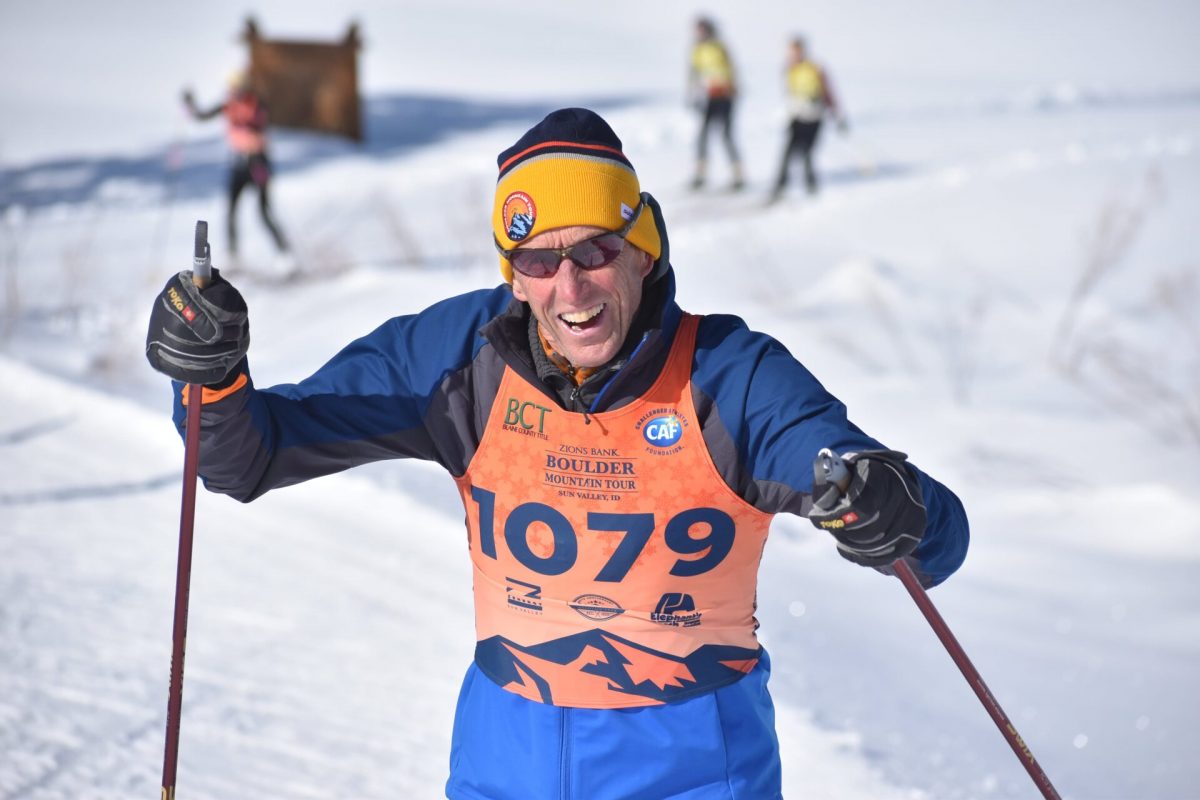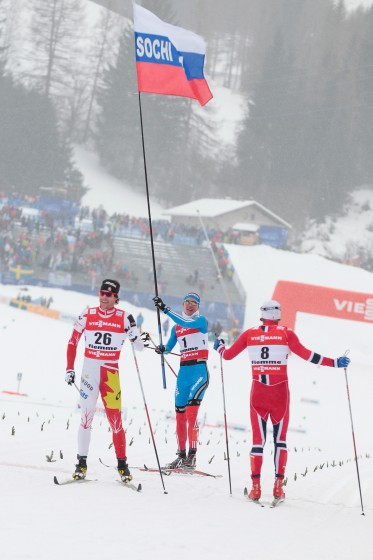
The Canadian World Cup Team plans to approach this season with a bit of a reserved fire, and who could blame them? This time last year, Devon Kershaw was sucking it up after tearing a ligament in his foot while running down stairs in Bruksvallarna, Sweden – a week before the World Cup started in Gällivare.
His teammate, Lenny Valjas sat out the team’s first FIS races in Bruksvallarna to give his broken pinky finger more time to heal. He broke it two days before flying to Sweden while tossing a football at home in Toronto. The recovery was expected to take up to six weeks; Valjas was racing in just over two.
Yet still the team pressed on, posting a solid opener in Bruks, where Chandra Crawford notched second in the freestyle sprint and eighth in the 5-kilometer classic, Ivan Babikov tallied third and Alex Harvey took fourth in the 10 k classic. Harvey placed eighth in the skate sprint, and Kershaw finished 10th in the 15 k skate.
The next weekend wasn’t so hot. Babikov was the lone Canadian World Cup skier (out of seven) to break through the top 30 individually. He placed 14th in the 15 k skate, and the next-best result from Harvey was 36th in the same race.
“I think having all that stuff happen last year – I am glad it is not happening right now,” Canadian World Cup Team Head Coach Justin Wadsworth said on the phone two weeks ago.
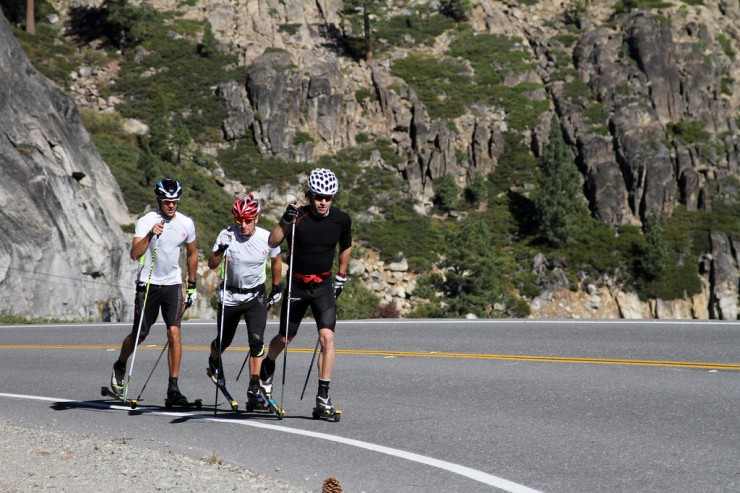
Valjas was rebounding from knee surgery in July, but able to keep up with his teammates in most of the workouts at their fall dryland camp in Truckee, Calif., Wadsworth said.
“We downplayed a lot of it [last year],” he added. “I think everyone forgets … they didn’t know how bad Devon’s ankle really was, and Lenny’s broken hand – he went through all the early season skiing with one pole and skiing in a cast after that. All those things, I think really added into the mojo, the overall lack of results last year.”
The team’s showing in Kuusamo, Finland, on the second World Cup weekend was better, with Perianne Jones pulling out 12th in the classic sprint and Gaiazova finishing one spot back in 13th.
But the small group was generally down a notch, playing catchup after a summer of training too aggressively and feeling slightly sluggish (even battered) coming into the 2012/2013 race season. Less than a month after arriving in Europe, the team jetted back to Canada for their home World Cups in Quebec and Canmore last December.
Expectations for the seven were high, with the entire team racing and a zealous crowd at both venues to back them up. Quebec’s pride and joy, Harvey produced the best Canadian individual result in Quebec City of 21st in the skate sprint, and was fifth in the freestyle team sprint with Kershaw. A week later, Harvey and Kershaw didn’t make the top 50 in the Canmore World Cup skate sprint and skipped the skiathlon there as a result.
The season was not lost, with Harvey coming back from a shoulder injury sustained in Sochi, Russia, to win bronze at World Championships in the classic sprint in Val di Fiemme, Italy. Babikov racked up another Canadian-male record there, placing fourth in the 15 k freestyle. Valjas finished the season stronger than ever, ranking eighth in the overall Sprint World Cup, and Babikov finished 20th overall – his best on the World Cup in eight seasons.
“We had a lot of stuff that happened last year,” Wadsworth said of the injuries and sicknesses that plagued his team throughout the season, including Kershaw’s stomach bug from mid-January to mid-February and Valjas’ strep throat throughout World Championships.
“When walking down icy stairs, I think they have a little tighter grip on the railing now,” Wadsworth added. “And just being a little more clear-headed so we don’t make any mistakes that might lead to an injury. At the same time, you can’t just be so cautious and tense all the time. I really like where we are right now. Everyone seems pretty loose and pretty focused on what they need to do, and that’s the main thing.”
The Game Plan
On Nov. 17, most of men’s team flew to Davos, Switzerland, to train for a couple weeks before the first World Cup races in Kuusamo this Friday through Sunday. In search of snow, the Quebec-based Harvey arrived Nov. 11 with his coach and the team’s assistant, Louis Bouchard, and enjoyed a week of good skiing in Davos with about four kilometers of natural snow until a thaw. The area expected more snow when the rest of the crew – Kershaw, Babikov, Valjas and last year’s NorAm leader Jess Cockney – arrived.
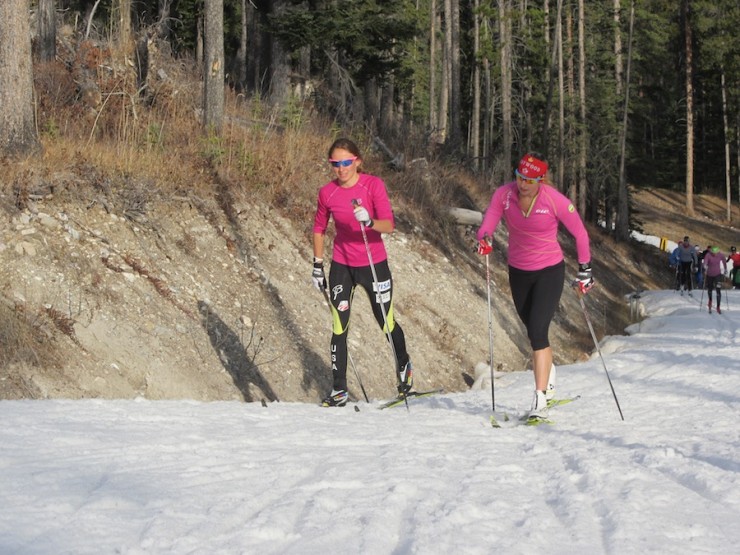
According to Wadsworth, Gaiazova planned to meet them in Kuusamo for her first races of the season, and Jones would fly over later, likely in mid-December. Crawford would open with three weekends of FIS races in Sweden (first in Bruksvallarna last weekend, Idre this weekend, and Östersund Dec. 7-8).
Crawford, who turned 30 on Nov. 19, declined a spot on the national team in April after choosing to end her World Cup season early last February.
“After a solid burn out and overload I’m re-charged and keen to make the most of the days until Sochi,” Crawford wrote in an email in May. “I have to manage my energy and do things in ways that work for me so while it’s financially sketchy it is the best option.”
She planned to work with personal coach Peter Larsson and joined Team Ninja, a band of four female nordic skiers in Canmore, Alberta. Technically prequalified for the Sochi Olympics (after notching sixth in the Canmore skate sprint last December), the 2006 Olympic gold medalist has to meet certain standards to prove she’s at World Cup and Olympic level again.
In three FIS skate sprints, Crawford must make “the basic criteria of top 12,” according to Wadsworth. She was 19th last Sunday in Bruksvallarna.
“If she does that, we’ll bring her on the World Cup, starting in Davos [Dec. 14-15],” he said.
In an email, Jones explained she won’t start the World Cup until probably Asiago, Italy, Dec. 21-22 after recent tests revealed she has hemochromatosis, a genetic condition that causes too much iron in the body. She was feeling fatigued as a result and spent the fall trying to figure out what was wrong.
“We are just taking some time to figure out how to manage it (blood letting is how to do that) but I can’t just dump a lot of blood, cause in this business blood volume is important also!” Jones, 28, wrote. “So my departure to Europe might be a little bit delayed, but I’m confident things are getting back on track.”
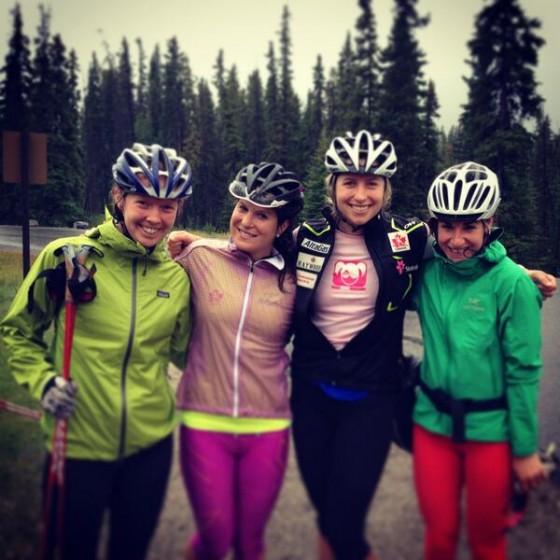
The reigning women’s NorAm leader, Amanda Ammar declined her Period I World Cup starts in an effort to recover from injuries in her back and foot. Her back has been bothering her for years, but a new kind of pain in her foot – caused by Morton’s neuroma (a nerve injury between the toes) – put her in the pool this summer. In an email, she explained her flat feet and tight ski boots were likely the culprits.
“Surgery is the solution to get rid of it, but I obviously can’t do that now,” the Team Ninja leader and former national-team skier wrote. “So we opted for a cortisone shot in the area. It seemed to help, and I’ve been able to train with no foot pain for at least a month and a half! ! We’re hoping that I won’t need any more cortisone shots this season, but I’m prepared to get another one if need be.”
She’s been maintaining both injuries since September, receiving prolotherapy in her back and seeing about six doctors about her foot. Unable to run, Ammar can ski and has the added bonus of being on snow in Canmore.
“I opted to not go to the early world cups because A.) Injury. I wanted to be close to my doctors and physio. I sometimes feel like I’m riding a very fine line,” she wrote. “Plus, going to Europe makes it an early season, and I just wasn’t feeling prepared after all my injuries [and] B) … My main focus is Olympic trials this year, and I want to do everything I can to be prepared and confident when I hit that start line.”
For Ammar, that means racing the NorAm openers in British Columbia (first at Sovereign Lake Dec. 7-8, and then in Rossland Dec. 14-15). Trials will take place in Canmore Jan. 8-12, and the Olympic qualifying period will end Jan. 18. Skiers can make the Olympic team by meeting various criteria, but the most surefire way to get in is top 12 in a World Cup distance race or top six in a sprint. Three World Cup top 30’s is another method.
Based on last season’s results, all seven World Cup members technically prequalified for the Sochi Games, but “they still have to show this year that they are going to be relatively competitive at the World Cup level,” Wadsworth explained.

In terms of discretion: “That’s pretty loose,” he said. “As long as they’re not, like, 60th in every single race on the World Cup and just bombing out, then we’ll take them. We expect that won’t be a consideration.”
Canada will field a team of 11, which will be decided internally, he said.
“[It] can be any combination – it can be six men, five women. It can be seven men, four women. It can be six women, five guys. We’ll just see how everybody’s racing and where our strengths and weakness are,” he added. “We want to take a competitive team.”
Wadsworth and the rest of the Cross Country Canada (CCC) staff decided on 11 to make the most of their athlete-to-staff ratio at the Olympics. Like the 2013 World Championships, Canada will have three coaches (Wadsworth, women’s coach Eric de Nys and Bouchard), seven waxers, a couple massage therapists and a doctor and physiologist in Sochi.
One of the first issues from last season that the team addressed was to improve race-day protocol to minimize waxing fiascos. Athletes are expected to arrive earlier for their races to work with their techs, Wadsworth explained. Having a brand-new wax truck to hang out inside “and be a little more tied to the waxing team” should also help, he said.
“We’ve also changed some of the roles of the waxers to get them out on the tracks more and closer to the track,” Wadsworth said. “Instead of being back in the wax room and making decisions from the wax room, there has been some small tweaks there that hopefully will pay off.”
An Olympic Year
After a rockstar season two years ago – in which Kershaw was the overall World Cup runner-up to Switzerland’s Dario Cologna – and a 2011 World Championships classic team sprint gold (won by Kershaw and Harvey), the Canadians are looking to break new ground at the 2014 Winter Games in Sochi.
The team has a published goal of two medals at the Olympics and eight World Cup podiums, but Wadsworth said the emphasis is definitely on the former. At the very least, he expects at least five World Cup podiums; in non-Olympic years, that goal is closer to 15.
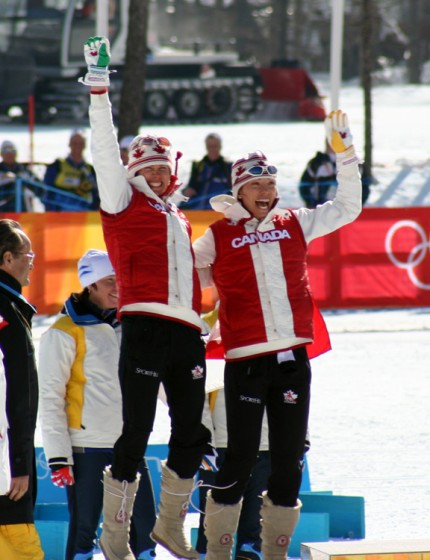
As for Olympic medals, Canada has not won seen any since 2006, when Crawford won the skate sprint in Turin, Italy, and Beckie Scott (Wadsworth’s wife) and Sara Renner teamed up to win silver. Scott was the nation’s first nordic skier to win gold at the 2002 Olympics in the 10 k skiathlon.
This time around, the men’s team is especially hungry.
“No Canadian man has ever stepped on the podium and that sucks,” Kershaw said on the phone last month while training in Davos. “Were better than that and the time is now.”
In late October, Kershaw joined the Norwegian men’s team at a camp in Val Senales, Italy, and spent the rest of November in Norway with his girlfriend, Kristin Størmer Steira, before the start of the season on Nov. 29.
In what could be Kershaw’s last Olympics (although he’s not entirely sure, and he plans to race through 2015), the 30 year old said his main goal is to bring an Olympic cross-country medal home. “I don’t care where it comes from,” he said.
Overall, Canada is hoping for a golden season with a team of mostly veterans (with the exception of Harvey and Valjas, both 25).
“We anticipate that perhaps Dasha, Peri and Chandra will [retire] after this year so we have to start grooming the younger crowd as well,” de Nys said on the phone in May. “There’s a fairly large gap from the World Cup level to the younger levels. … We have to make sure we keep building up …”
Dealt a seasoned squad – with everyone but Valjas racing at the 2010 Vancouver Olympics – Wadsworth wouldn’t have it any other way.
“Everyone on our World Cup team has medaled on the World Cup,” he said. “That’s huge. That feels good to know that everyone is pretty solid and can produce a result on the right day. … We were three inches away from getting two medals at the World Championships last year, which was our goal there.”
Kershaw and Harvey placed fourth in the freestyle sprint in Val di Fiemme, missing third by three-hundredths of a second.
“We feel realistic about two medals at the Games, should be pretty much doable,” Wadsworth added. “I’m really satisfied where everyone is right now.”
Playing to Harvey and Kershaw’s favor, the Olympic team sprint is a classic race.
In an email, Harvey wrote that he was healthy: “no illness, no injury. Knocking on wood!” As for goals, he’s ultimately eyeing the Olympics.
“Getting up to speed as the season progresses is the plan but it’s always motivating to race fast, no matter what the time of the year it is,” Harvey wrote. “So being in the fight for top spots early on would be nice too!”
That said, Wadsworth isn’t stressing early results; he’d like to see his athletes ease into the season. Last year, he felt their eagerness to race got the best of them and recovery lacked as a result. This season, they’ve been careful to manage that.
“It is a good place to be coming from when you don’t have too much confidence coming into a season like this,” he said. “Everybody’s careful along the way and just trying to do the best they can, and not just thinking we can do everything we want and still roll over everybody on the weekends. I think this is a cautiously optimistic team and we are going to start the season nice and controlled and relaxed, no panic, and know that the big prize is in February.”
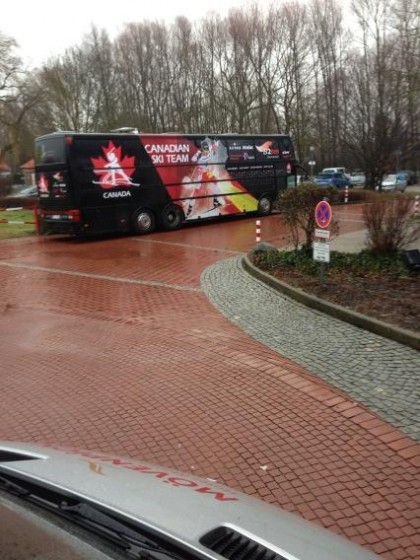
In preparation, the whole team plans to race at least part of the Tour de Ski.
“Some athletes and maybe teams are wanting to stay away from the Tour this year, but I look at it as the opposite,” Wadsworth said. “Only seven days of racing in that period, it is actually the perfect tuneup for us leading into the Olympics. The guys will be there and the women will be there for the first two stages. It’ll be nice to have everybody there racing.”
Another incentive to participate in the multi-stage event is work on recovering between races, and the Canadians have a Greyhound-size bus to help them with that. “We do the recovery aspect of it so well during the Tour,” Wadsworth said.
Regarding Olympic pressure, Wadsworth said the stakes are higher because the development of Canadian skiing depends on their success.
“I don’t feel like there is pressure; I know the reality of the situation,” he said. “A lot of people have invested in our team, from Own The Podium to all of our sponsors, and we have performed at a high level and kept a lot of our partners and people happy and showed that the ski community in Canada that there’s a great program and we can develop athletes.
“I think that’s really good, for younger skiers coming up, to see that” he added. “It started with Beckie and Sara, that generation, and we are kind of continuing that. But if the results aren’t there, expected with the program and the talent we have, then there will be some questions to answer and a lot of them will have dollar signs attached to them.”
In the end, “a lot of the future of our program hinges on the balance of these Games,” he said. “If we come out of it with really disappointing results, I think we are going to see a big shift in our overall programming. We are really going to have to go back to the drawing board and make sure we are developing the development team now, and there will be a lot of resources lost at the high end.
“If we do get our medals and our top results that we want there, it is going to be a big boost for the program … [and] at the same time get more resources for our developing athletes.”
The season starts Friday in Kuusamo with the World Cup 1.4 k classic sprint.
Alex Kochon
Alex Kochon (alexkochon@gmail.com) is a former FasterSkier editor and roving reporter who never really lost touch with the nordic scene. A freelance writer, editor, and outdoor-loving mom of two, she lives in northeastern New York and enjoys adventuring in the Adirondacks. She shares her passion for sports and recreation as the co-founder of "Ride On! Mountain Bike Trail Guide" and a sales and content contributor at Curated.com. When she's not skiing or chasing her kids around, Alex assists authors as a production and marketing coordinator for iPub Global Connection.

